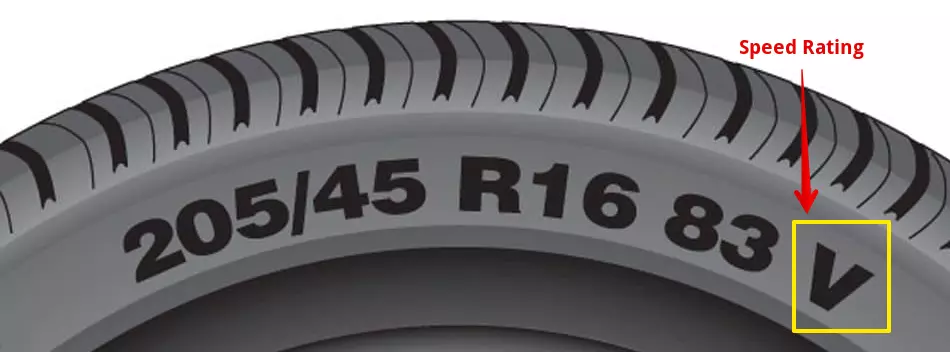Tire Speed Rating Chart

What does the tire speed rating mean?
Every car tire comes with a specific speed and load capacities. The tire speed rating is the maximum speed that a tire can reach under recommended loads for a sustained amount of time under ideal operating conditions. Higher speed ratings provide better handling and control characteristics at higher speeds.
Once you pass the threshold, the performance drops, and they are no longer considered safe. In some instances, the tires may start to degrade, which can be catastrophic.
Exceeding the speed ratings reduces the safety and performance of the tires. Standard speed ratings are denoted using the letters A to Z, with corresponding maximum speeds of 3 mph to 186 mph, respectively.
Speed rating values are experimental and obtained by testing tire characteristics under simulated loads to identify maximum tire speeds.
Why Were Speed Ratings Developed?
Tire manufacturers adopt different manufacturing processes and standards. Speed ratings were introduced as a means to control and ensure the safe performance of diverse tire brands at standardized operating speeds. Initial speed ratings designated unlimited V (over 130 mph) as the highest tire speed rating.
As cars became faster throughout history, tire manufacturers had to keep up the pace and design tires to withstand the speeds. Over time, more manufacturers started to get in on the business, and more models were introduced. To keep the price range wide and offer cheaper and more expletive premium tires, certain decisions had to be made.
One of those decisions is the tire speed rating. The general rule is that the lower the price, the lower the speed rating. This was also good news for less powerful cars as they didn’t have any need for high-performing tires that can be operated at a speed much higher than the vehicle can reach.
Places to Look for Tire Speed Rating
The speed rating is usually simple to identify as it appears as the last item in the tire’s size code. Car manufacturers recommend specific speed ratings that are included in the car manual. Speed ratings can be found on other locations that bear tire size codes for the car, including the driver’s side door jamb, gas tank hatch or inside the glove door hatch. Speed ratings on tires are usually inscribed on the sidewall of the tire. For instance, for a tire coded as 225/70R16 85S, S represents the speed rating, with maximum speed capabilities of 112 mph.
The tire speed rating will mostly depend on your vehicle, so the first place to look is the user manual. Alternatively, you can look at the maintenance stickers at the door or in the glovebox.
If your previous tires were purchased per the manufacturer’s requirements, you could use them as a guide. You can find the tire speed rating on the sidewall right next to the size and load index. For example, if the sidewall says: “195/70R13 75M,” the tire speed rating is the last letter “M.”
What Are Z Rated Tires?
Before explaining the ZR designation, first, let’s look at the other ratings. The speed rating ranges from 75 mph and goes over 186 mph. Each increase is several miles per hour higher than the previous one and gets a letter that helps you identify the rating quickly.
The ZR designation is aimed at higher-performance cars that can reach maximum speeds over 149 mph. This is a separate category consisting of 3-speed ratings: 168, 186, and above 186 mph.
Z rating is a designation that may appear in the middle of the tire’s information, adopted for high-performance tires. Z rating is adopted for tires with maximum speed capabilities of over 149 mph. High-performance tires are wider and smoother compared to regular tires, providing an increased contact surface area. ZR designation must be included for tires whose maximum speed capability exceeds 186 mph.
ZR Designation Examples
| Tire Designation | Maximum Speed |
| P 245/45ZR18 100W | 270 km/h (168 mph) |
| P 225/40ZR18 92Y | 300 km/h (186 mph) |
Tire Speed Rating Chart
A speed rating chart is used to indicate the standard maximum speed capacities for different types and sizes of tires under optimal operating conditions. Speed ratings are designated using alphabetic symbols, A to Z, with the exclusion of I, O, and U. A rating corresponds to maximum performance speeds of 3 mph, and Z corresponds to speeds above 186 mph.
There are 15 speed ratings for cars, and you’ll be able to find each in the chart below. Keep in mind that the letters are not in order, and if you notice some of them out of place, it’s not a typo; that is how the ratings are marked.
| Speed Symbol | Max Speed (km/h) | Max Speed (mph) |
| A1 | 5 | 3 |
| A2 | 10 | 6 |
| A3 | 15 | 9 |
| A4 | 20 | 12 |
| A5 | 25 | 16 |
| A6 | 30 | 19 |
| A8 | 40 | 25 |
| B | 50 | 31 |
| C | 60 | 37 |
| D | 65 | 40 |
| E | 70 | 43 |
| F | 80 | 50 |
| G | 90 | 56 |
| J | 100 | 62 |
| K | 110 | 68 |
| L | 120 | 75 |
| M | 130 | 81 |
| N | 140 | 87 |
| P | 150 | 94 |
| Q | 160 | 100 |
| R | 170 | 106 |
| S | 180 | 112 |
| T | 190 | 118 |
| U | 200 | 124 |
| H | 210 | 130 |
| V | 240 | 149 |
| W* | 270 | 168 |
| Y** | 300 | 186 |
| (Y)** | Above 300 | Above 186 |
**If the tire’s maximum speed exceeds 186 mph (Y speed symbol), a ZR is obligatory.
FAQ
Does Tire Speed Rating Matter?
Yes. Higher tire ratings provide better car handling and control at higher speeds. Highly rated tires have a better grip on the road, characterized by improved braking characteristics. Highly rated tires, however, wear and tear faster than low rated ones.
Car manufacturers optimize suspension and car handling accessories depending on originally installed tires. Using tires with lower or extremely higher speed ratings distorts recommended driving conditions, which affects safety and comfort.
Getting tires with higher speed ratings will not provide any advantages. On the other hand, I wouldn’t advise you to get tires with a lower speed rating than the manufacturer’s requirements.
What is the best speed rating for a tire?
Speed ratings vary depending on the type of vehicle and driving conditions. Car owners are required to use tire ratings and sizes as described by the car manufacturer in the manual. Fitting tires of lower ratings than the original ones is not recommended as it leads to increased safety risks.
What is the highest speed rating of a tire?
The highest speed rating for tires is the ZR rating, for tires having maximum speed capabilities of over 149mph. The ZR designation is also included for high-performance tires with speed capabilities of over 186mph.
Which is better T or H rating?
T rated tires have a maximum speed capability of 118mph as compared to H rated tires, capable of running well at 130mph. H rated tires provide firmer grip on the road, more comfortable rides and improved handling characteristics compared to T rated tires.
What is H or V rating in a tire?
H and V ratings are designations for passenger tires. H-rated tires have a maximum speed capability of 130mph. V-rated tires step up maximum speed capabilities to a maximum of 149mph. H-rated tires are optimized for all-weather performance and longer tread life. V-rated tires are performance tires that are optimized for handling and dry road traction.
Does the speed rating affect ride quality?
No, the ride quality on the tires is not affected by the speed rating.
External sources used while preparing the article:
Federal Motor Vehicle Safety Standards; Tires
http://www.lb7.uscourts.gov/documents/15-529URL1Tirecode.pdf






